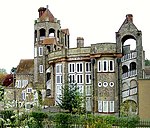Knebworth Park and Winter Green Railway
The Knebworth and Winter Green Railway was a 1 ft 11+1⁄2 in (597 mm) narrow gauge railway built in the grounds of Knebworth House in 1972 as a tourist attraction. The railway was built by Pleasurerail Ltd. a company set up to build and operate private tourist railways which included the Great Whipsnade Railway and also the line at Blenheim Palace. In 1971, they started construction on a railway in the grounds of Knebworth House near Stevenage. The initial line was an end-to-end layout running from the house to the adventure playground. In 1980, the track was extended to form a mile-long continuous loop. During its existence, the line hosted a number of steam and diesel locomotives. The line continued to run until 1990 when it was lifted and the remaining stock transferred to other lines
Excerpt from the Wikipedia article Knebworth Park and Winter Green Railway (License: CC BY-SA 3.0, Authors).Knebworth Park and Winter Green Railway
Denby,
Geographical coordinates (GPS) Address Nearby Places Show on map
Geographical coordinates (GPS)
| Latitude | Longitude |
|---|---|
| N 51.972 ° | E -0.212 ° |
Address
Denby
Denby
SG6 2LF , Jackmans Estate
England, United Kingdom
Open on Google Maps









